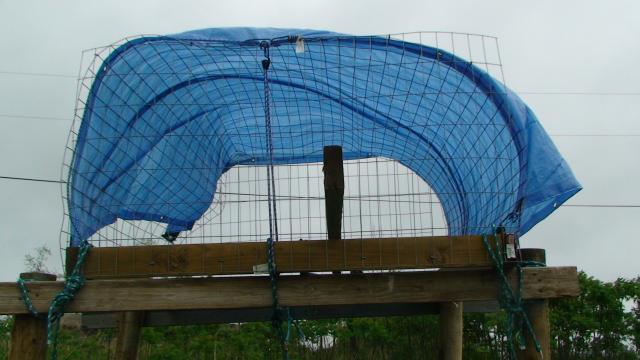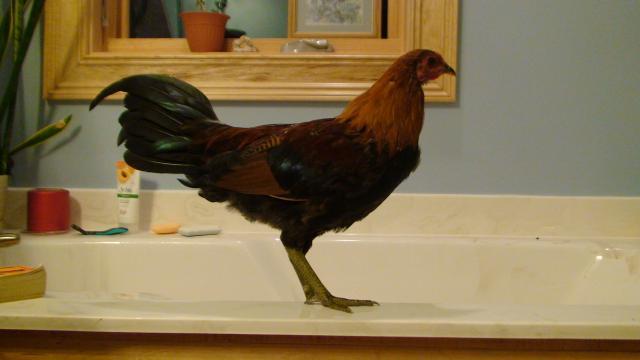- Thread starter
- #281
Quote:
Yes I am a professor ..of fish. Professors do lack some typical inhibitions making them prone to get excited over some pretty silly stuff. It is hard not to be a scientist; it is hard to invest so many years in becoming one and never truly growing up.
Quote:
My experience with similar involved scarecrows used for great blue herons and ospreys. Shape, coloration and simply changing position do not make for a good scarecrow. Eyes need to track critter you want to intimidate. Sometimes critter needs to be threatened as well, otherwise it will ignore to point where it will approach to within feet. I am not familiar with laser technology. It needs to be tested in realistic setting where predator can come from a range of directions including vertically. Also need to consider predator is likely to approach many times over many nights before deciding device is not a threat. In my situation foxes and coyotes are coming through, sometimes between pens and roosts, many times before actually going after my birds. They are clearly aware of birds in pens and very likely aware of those in elevated roost. I do not know why they forgo birds to chase smaller voles but dog I think if part of reason. Such predators may be considering risk posed by chicken alarm system and dog responding. Voles make no such alarms.
Sallie is out. I am trying to get one last clutch for incubation indoors. Nutrition for molt better free range anyway.
Quote:
I prefer use of predator resistance or predator management to predator proofing. I still lose a few but losses to cocci and poor management of scratch grain applications were greater this year.
Red jungle fowl eggs being consumed now to prevent broodiness. They lay very well even during molt if forage quality and quantity high.
The ability to access an elevated roost by flight is a key component of my Missouri Dominique selection efforts. Pure American Dominiques slower to acquire flight capacity required for reaching roost as juveniles and mature adults have reduced flight capacity relative to young adults and advanced juveniles. Hens in egg laying mode cannot fly as well as those not laying and progression thru molt does not help either. I am resorting to introducing American game and California grey into my Missouri Dominique project to enhance flight capacity and egg production. Dom x California Grey can fly well enough but they are prone not to use available roost. Roost usage is being used a selection criterion as much as production and adherence to SOP for American Dominiques. I am not well versed enough with broods other than what I have now to suggest any other than American Games or their crosses are good for free-range production under low predator pressure conditions. Not all American Games are similar in respect to free ranging survival quality. We (my family) has always known the intensively pen reared strains have lost much of their free range survival qualities making them unreliable producers of stags on walks. What I have come to be skeptical of is assertions about free-range performance of heirloom / heritage breeds. They either never performed they way I interpret accounts about past production or selection over last decades has degraded performance in a free range setting. Possibly both are at play. F1 cross of American Game with sire being game should enable generating ample numbers of chicks that have reasonably good production characteristics. Multiple crosses may need to be explored to find one that nicks for your application.
Yes I am a professor ..of fish. Professors do lack some typical inhibitions making them prone to get excited over some pretty silly stuff. It is hard not to be a scientist; it is hard to invest so many years in becoming one and never truly growing up.
Quote:
My experience with similar involved scarecrows used for great blue herons and ospreys. Shape, coloration and simply changing position do not make for a good scarecrow. Eyes need to track critter you want to intimidate. Sometimes critter needs to be threatened as well, otherwise it will ignore to point where it will approach to within feet. I am not familiar with laser technology. It needs to be tested in realistic setting where predator can come from a range of directions including vertically. Also need to consider predator is likely to approach many times over many nights before deciding device is not a threat. In my situation foxes and coyotes are coming through, sometimes between pens and roosts, many times before actually going after my birds. They are clearly aware of birds in pens and very likely aware of those in elevated roost. I do not know why they forgo birds to chase smaller voles but dog I think if part of reason. Such predators may be considering risk posed by chicken alarm system and dog responding. Voles make no such alarms.
Sallie is out. I am trying to get one last clutch for incubation indoors. Nutrition for molt better free range anyway.
Quote:
I prefer use of predator resistance or predator management to predator proofing. I still lose a few but losses to cocci and poor management of scratch grain applications were greater this year.
Red jungle fowl eggs being consumed now to prevent broodiness. They lay very well even during molt if forage quality and quantity high.
The ability to access an elevated roost by flight is a key component of my Missouri Dominique selection efforts. Pure American Dominiques slower to acquire flight capacity required for reaching roost as juveniles and mature adults have reduced flight capacity relative to young adults and advanced juveniles. Hens in egg laying mode cannot fly as well as those not laying and progression thru molt does not help either. I am resorting to introducing American game and California grey into my Missouri Dominique project to enhance flight capacity and egg production. Dom x California Grey can fly well enough but they are prone not to use available roost. Roost usage is being used a selection criterion as much as production and adherence to SOP for American Dominiques. I am not well versed enough with broods other than what I have now to suggest any other than American Games or their crosses are good for free-range production under low predator pressure conditions. Not all American Games are similar in respect to free ranging survival quality. We (my family) has always known the intensively pen reared strains have lost much of their free range survival qualities making them unreliable producers of stags on walks. What I have come to be skeptical of is assertions about free-range performance of heirloom / heritage breeds. They either never performed they way I interpret accounts about past production or selection over last decades has degraded performance in a free range setting. Possibly both are at play. F1 cross of American Game with sire being game should enable generating ample numbers of chicks that have reasonably good production characteristics. Multiple crosses may need to be explored to find one that nicks for your application.



